Abstract
It has previously been reported that the expression of the complement receptors, CR1 on erythrocytes and blood leucocytes and CR2 on B cells, is reduced in patients with SLE, and that the reduced expression of CR1 on erythrocytes is related to disease activity. We have earlier demonstrated that normal B cells are capable of activating the alternative pathway (AP) of complement in a CR2-dependent fashion. In this study we have investigated whether disturbances in this activity may be related to the altered phenotype of SLE B cells. Flow cytometry was used to measure expression of complement receptors and regulatory proteins on B cells from SLE patients, as well as the deposition of C3 fragments occurring in vivo or after in vitro AP activation. We have confirmed, for a proportion of the patients studied, reduced expression of CR1 and CR2 on B cells, and shown a consistency between low CR2 expression and reduced in vitro AP activation in the presence of homologous, normal serum. In addition, the B cells, like erythrocytes, bear raised levels of in vivo-deposited C3dg, but not C3b fragments, compared with normal B cells. The erythrocytes from SLE patients were unable to inhibit in vitro AP activation by B cells in homologous serum. Finally, we demonstrated an inverse relationship between SLE disease activity index (SLEDAI) and the expression of complement receptor 2 (CR2) on SLE B cells. Thus, determination of CR2 on B cells may emerge as an additional laboratory tool in the assessment of SLE activity.
Full text
PDF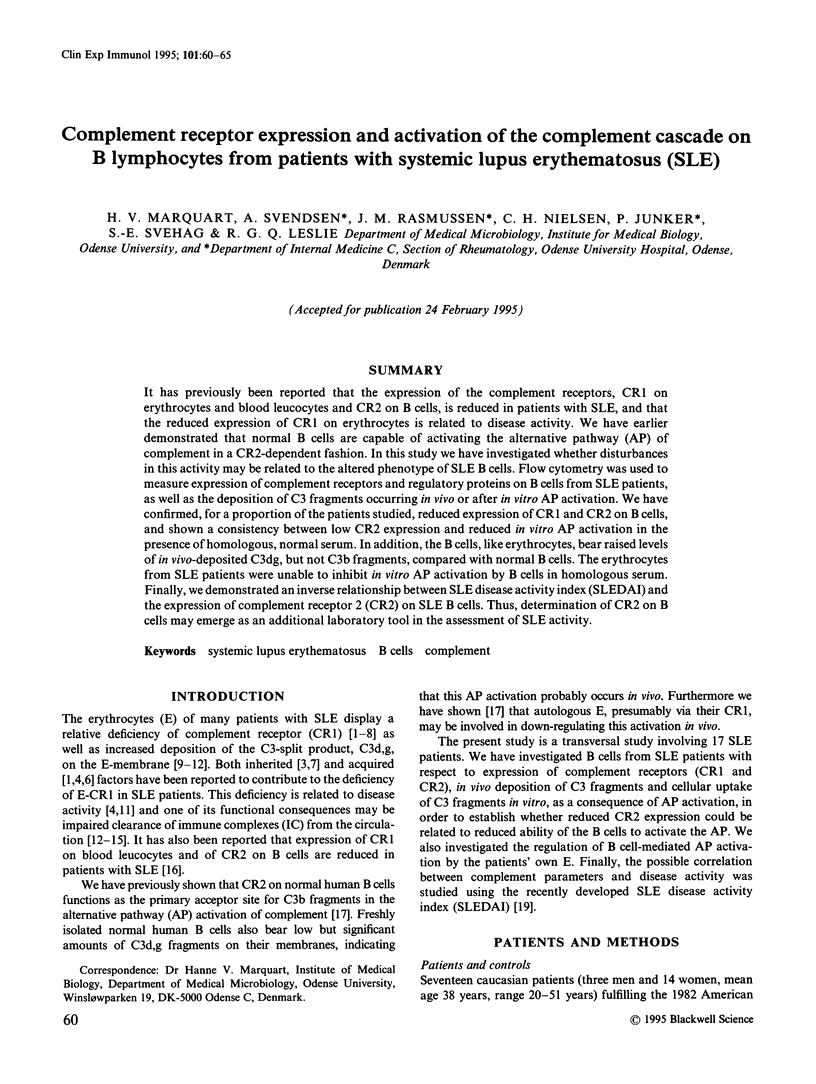
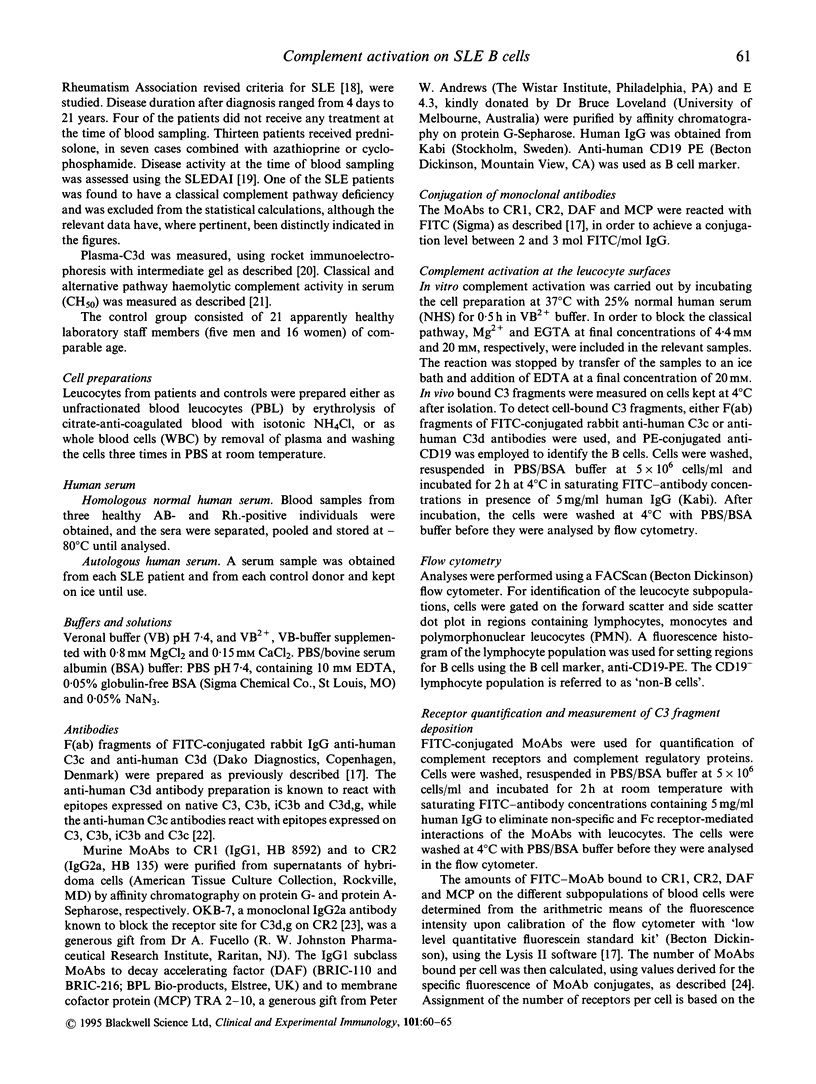
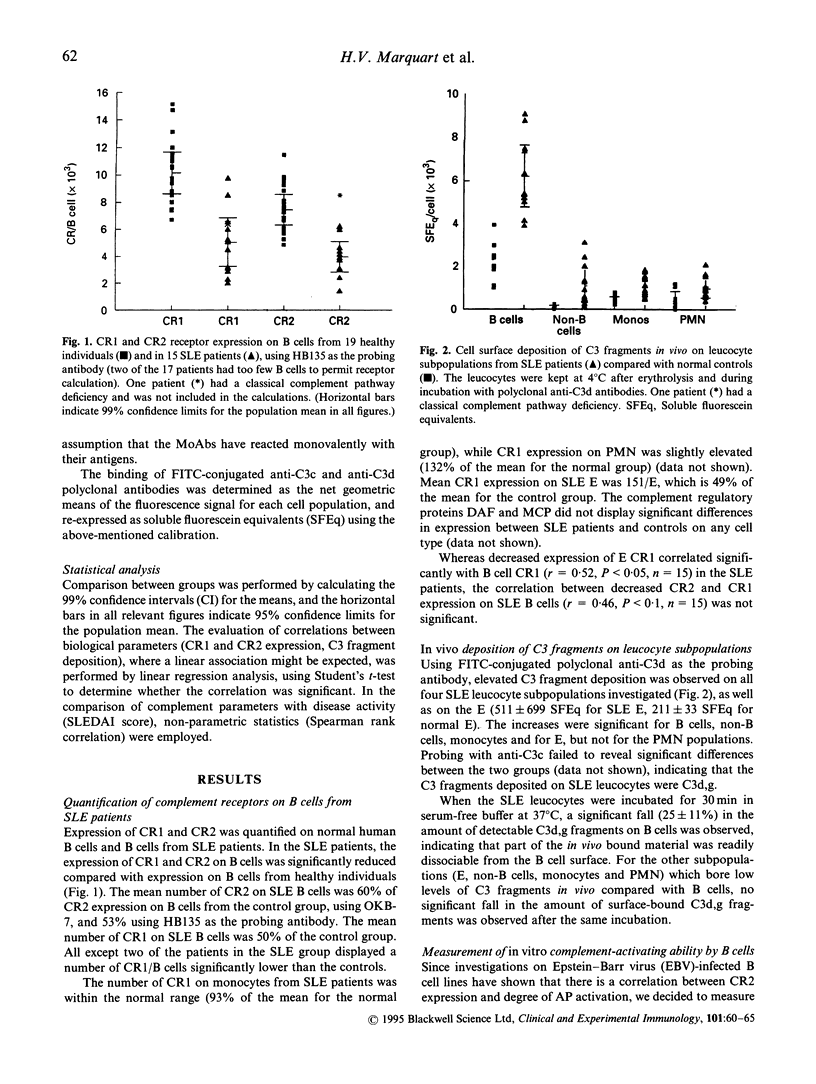
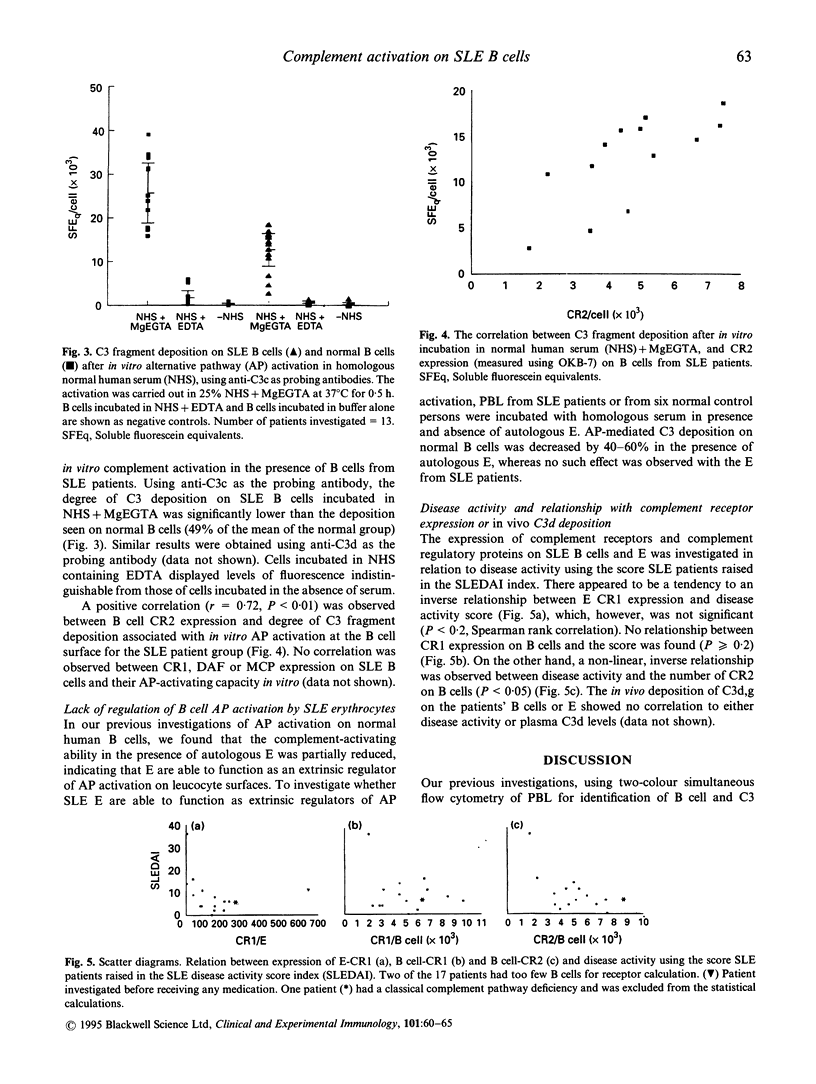
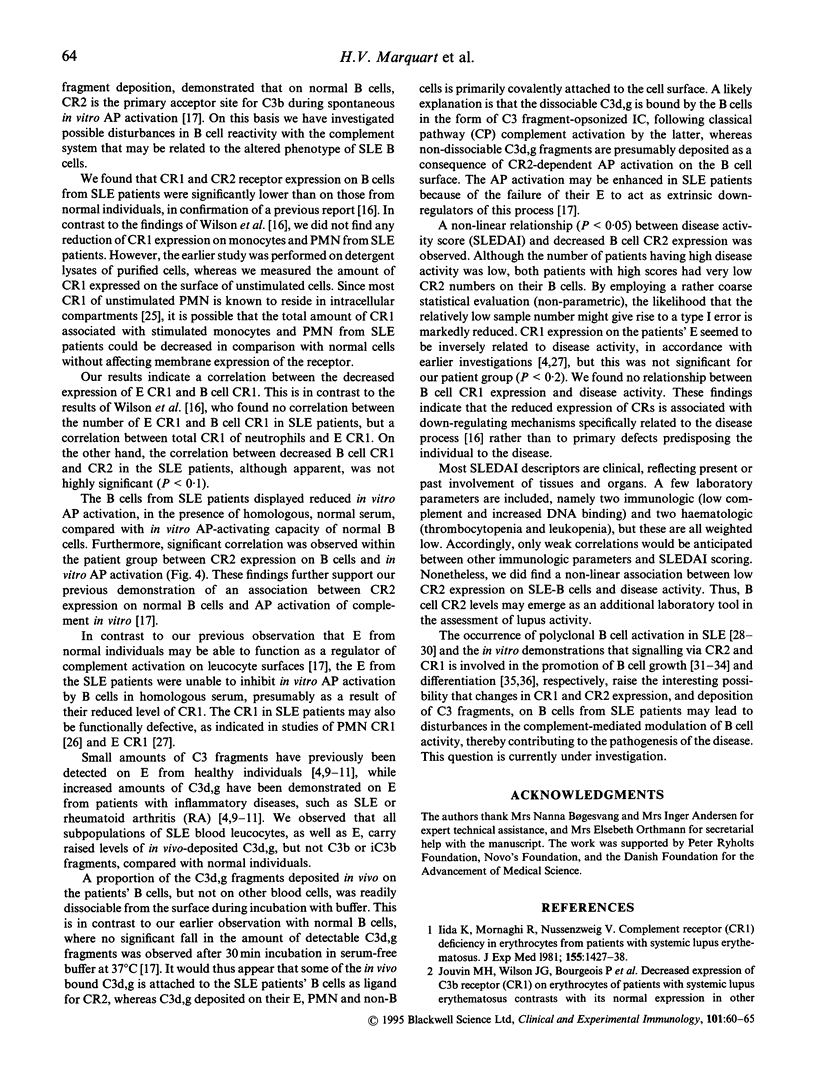
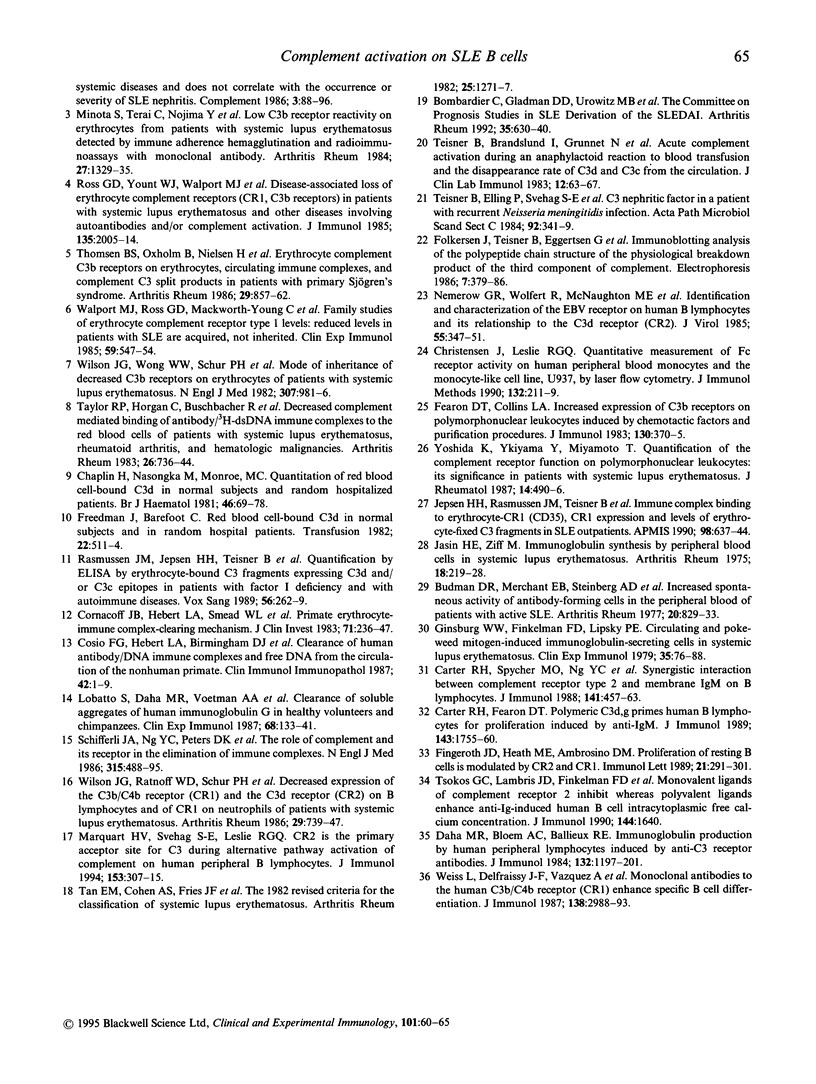
Selected References
These references are in PubMed. This may not be the complete list of references from this article.
- Bombardier C., Gladman D. D., Urowitz M. B., Caron D., Chang C. H. Derivation of the SLEDAI. A disease activity index for lupus patients. The Committee on Prognosis Studies in SLE. Arthritis Rheum. 1992 Jun;35(6):630–640. doi: 10.1002/art.1780350606. [DOI] [PubMed] [Google Scholar]
- Budman D. R., Merchant E. B., Steinberg A. D., Doft B., Gershwin M. E., Lizzio E., Reeves J. P. Increased spontaneous activity of antibody-forming cells in the peripheral blood of patients with active SLE. Arthritis Rheum. 1977 Apr;20(3):829–833. doi: 10.1002/art.1780200312. [DOI] [PubMed] [Google Scholar]
- Carter R. H., Fearon D. T. Polymeric C3dg primes human B lymphocytes for proliferation induced by anti-IgM. J Immunol. 1989 Sep 15;143(6):1755–1760. [PubMed] [Google Scholar]
- Carter R. H., Spycher M. O., Ng Y. C., Hoffman R., Fearon D. T. Synergistic interaction between complement receptor type 2 and membrane IgM on B lymphocytes. J Immunol. 1988 Jul 15;141(2):457–463. [PubMed] [Google Scholar]
- Chaplin H., Nasongkla M., Monroe M. C. Quantitation of red blood cell-bound C3d in normal subjects and random hospitalized patients. Br J Haematol. 1981 May;48(1):69–78. doi: 10.1111/j.1365-2141.1981.00069.x. [DOI] [PubMed] [Google Scholar]
- Christensen J., Leslie R. G. Quantitative measurement of Fc receptor activity on human peripheral blood monocytes and the monocyte-like cell line, U937, by laser flow cytometry. J Immunol Methods. 1990 Sep 14;132(2):211–219. doi: 10.1016/0022-1759(90)90032-q. [DOI] [PubMed] [Google Scholar]
- Cornacoff J. B., Hebert L. A., Smead W. L., VanAman M. E., Birmingham D. J., Waxman F. J. Primate erythrocyte-immune complex-clearing mechanism. J Clin Invest. 1983 Feb;71(2):236–247. doi: 10.1172/JCI110764. [DOI] [PMC free article] [PubMed] [Google Scholar]
- Cosio F. G., Hebert L. A., Birmingham D. J., Dorval B. L., Bakaletz A. P., Kujala G. A., Edberg J. C., Taylor R. P. Clearance of human antibody/DNA immune complexes and free DNA from the circulation of the nonhuman primate. Clin Immunol Immunopathol. 1987 Jan;42(1):1–9. doi: 10.1016/0090-1229(87)90167-x. [DOI] [PubMed] [Google Scholar]
- Daha M. R., Bloem A. C., Ballieux R. E. Immunoglobulin production by human peripheral lymphocytes induced by anti-C3 receptor antibodies. J Immunol. 1984 Mar;132(3):1197–1201. [PubMed] [Google Scholar]
- Fearon D. T., Collins L. A. Increased expression of C3b receptors on polymorphonuclear leukocytes induced by chemotactic factors and by purification procedures. J Immunol. 1983 Jan;130(1):370–375. [PubMed] [Google Scholar]
- Fingeroth J. D., Heath M. E., Ambrosino D. M. Proliferation of resting B cells is modulated by CR2 and CR1. Immunol Lett. 1989 Jun 15;21(4):291–301. doi: 10.1016/0165-2478(89)90022-9. [DOI] [PubMed] [Google Scholar]
- Freedman J., Barefoot C. Red blood cell-bound C3d in normal subjects and in random hospital patients. Transfusion. 1982 Nov-Dec;22(6):511–514. doi: 10.1046/j.1537-2995.1982.22683068615.x. [DOI] [PubMed] [Google Scholar]
- Ginsburg W. W., Finkelman F. D., Lipsky P. E. Circulating and pokeweed mitogen-induced immunoglobulin-secreting cells in systemic lupus erythematosus. Clin Exp Immunol. 1979 Jan;35(1):76–88. [PMC free article] [PubMed] [Google Scholar]
- Iida K., Mornaghi R., Nussenzweig V. Complement receptor (CR1) deficiency in erythrocytes from patients with systemic lupus erythematosus. J Exp Med. 1982 May 1;155(5):1427–1438. doi: 10.1084/jem.155.5.1427. [DOI] [PMC free article] [PubMed] [Google Scholar]
- Jasin H. E., Ziff M. Immunoglobulin synthesis by peripheral blood cells in systemic lupus erythematosus. Arthritis Rheum. 1975 May-Jun;18(3):219–228. doi: 10.1002/art.1780180305. [DOI] [PubMed] [Google Scholar]
- Jepsen H. H., Møller Rasmussen J., Teisner B., Schrøder L., Holmskov U., Jarlbaek L., Isager H., Svehag S. E. Immune complex binding to erythrocyte-CR1 (CD 35), CR1 expression and levels of erythrocyte-fixed C3 fragments in SLE outpatients. APMIS. 1990 Jul;98(7):637–644. doi: 10.1111/j.1699-0463.1990.tb04981.x. [DOI] [PubMed] [Google Scholar]
- Lobatto S., Daha M. R., Voetman A. A., Evers-Schouten J. H., Van Es A. A., Pauwels E. K., Van Es L. A. Clearance of soluble aggregates of human immunoglobulin G in healthy volunteers and chimpanzees. Clin Exp Immunol. 1987 Jul;69(1):133–141. [PMC free article] [PubMed] [Google Scholar]
- Marquart H. V., Svehag S. E., Leslie R. G. CR2 is the primary acceptor site for C3 during alternative pathway activation of complement on human peripheral B lymphocytes. J Immunol. 1994 Jul 1;153(1):307–315. [PubMed] [Google Scholar]
- Minota S., Terai C., Nojima Y., Takano K., Takai E., Miyakawa Y., Takaku F. Low C3b receptor reactivity on erythrocytes from patients with systemic lupus erythematosus detected by immune adherence hemagglutination and radioimmunoassays with monoclonal antibody. Arthritis Rheum. 1984 Dec;27(12):1329–1335. doi: 10.1002/art.1780271202. [DOI] [PubMed] [Google Scholar]
- Møller Rasmussen J., Jepsen H. H., Teisner B., Holmskov-Nielsen U., Rasmussen G. G., Svehag S. E. Quantification by ELISA of erythrocyte-bound C3 fragments expressing C3d and/or C3c epitopes in patients with factor I deficiency and with autoimmune diseases. Vox Sang. 1989;56(4):262–269. doi: 10.1111/j.1423-0410.1989.tb02039.x. [DOI] [PubMed] [Google Scholar]
- Nemerow G. R., Wolfert R., McNaughton M. E., Cooper N. R. Identification and characterization of the Epstein-Barr virus receptor on human B lymphocytes and its relationship to the C3d complement receptor (CR2). J Virol. 1985 Aug;55(2):347–351. doi: 10.1128/jvi.55.2.347-351.1985. [DOI] [PMC free article] [PubMed] [Google Scholar]
- Ross G. D., Yount W. J., Walport M. J., Winfield J. B., Parker C. J., Fuller C. R., Taylor R. P., Myones B. L., Lachmann P. J. Disease-associated loss of erythrocyte complement receptors (CR1, C3b receptors) in patients with systemic lupus erythematosus and other diseases involving autoantibodies and/or complement activation. J Immunol. 1985 Sep;135(3):2005–2014. [PubMed] [Google Scholar]
- Schifferli J. A., Ng Y. C., Peters D. K. The role of complement and its receptor in the elimination of immune complexes. N Engl J Med. 1986 Aug 21;315(8):488–495. doi: 10.1056/NEJM198608213150805. [DOI] [PubMed] [Google Scholar]
- Tan E. M., Cohen A. S., Fries J. F., Masi A. T., McShane D. J., Rothfield N. F., Schaller J. G., Talal N., Winchester R. J. The 1982 revised criteria for the classification of systemic lupus erythematosus. Arthritis Rheum. 1982 Nov;25(11):1271–1277. doi: 10.1002/art.1780251101. [DOI] [PubMed] [Google Scholar]
- Taylor R. P., Horgan C., Buschbacher R., Brunner C. M., Hess C. E., O'Brien W. M., Wanebo H. J. Decreased complement mediated binding of antibody/3H-dsDNA immune complexes to the red blood cells of patients with systemic lupus erythematosus, rheumatoid arthritis, and hematologic malignancies. Arthritis Rheum. 1983 Jun;26(6):736–744. doi: 10.1002/art.1780260606. [DOI] [PubMed] [Google Scholar]
- Teisner B., Brandslund I., Grunnet N., Hansen L. K., Thellesen J., Svehag S. E. Acute complement activation during an anaphylactoid reaction to blood transfusion and the disappearance rate of C3c and C3d from the circulation. J Clin Lab Immunol. 1983 Oct;12(2):63–67. [PubMed] [Google Scholar]
- Teisner B., Elling P., Svehag S. E., Poulsen L., Lamm L. U., Sjöholm A. C3 nephritic factor in a patient with recurrent Neisseria meningitidis infections. Acta Pathol Microbiol Immunol Scand C. 1984 Dec;92(6):341–349. doi: 10.1111/j.1699-0463.1984.tb00098.x. [DOI] [PubMed] [Google Scholar]
- Thomsen B. S., Oxholm P., Manthorpe R., Nielsen H. Complement C3b receptors on erythrocytes, circulating immune complexes, and complement C3 split products in patients with primary Sjögren's syndrome. Arthritis Rheum. 1986 Jul;29(7):857–862. doi: 10.1002/art.1780290707. [DOI] [PubMed] [Google Scholar]
- Tsokos G. C., Lambris J. D., Finkelman F. D., Anastassiou E. D., June C. H. Monovalent ligands of complement receptor 2 inhibit whereas polyvalent ligands enhance anti-Ig-induced human B cell intracytoplasmic free calcium concentration. J Immunol. 1990 Mar 1;144(5):1640–1645. [PubMed] [Google Scholar]
- Walport M. J., Ross G. D., Mackworth-Young C., Watson J. V., Hogg N., Lachmann P. J. Family studies of erythrocyte complement receptor type 1 levels: reduced levels in patients with SLE are acquired, not inherited. Clin Exp Immunol. 1985 Mar;59(3):547–554. [PMC free article] [PubMed] [Google Scholar]
- Weiss L., Delfraissy J. F., Vazquez A., Wallon C., Galanaud P., Kazatchkine M. D. Monoclonal antibodies to the human C3b/C4b receptor (CR1) enhance specific B cell differentiation. J Immunol. 1987 May 1;138(9):2988–2993. [PubMed] [Google Scholar]
- Wilson J. G., Ratnoff W. D., Schur P. H., Fearon D. T. Decreased expression of the C3b/C4b receptor (CR1) and the C3d receptor (CR2) on B lymphocytes and of CR1 on neutrophils of patients with systemic lupus erythematosus. Arthritis Rheum. 1986 Jun;29(6):739–747. doi: 10.1002/art.1780290606. [DOI] [PubMed] [Google Scholar]
- Wilson J. G., Wong W. W., Schur P. H., Fearon D. T. Mode of inheritance of decreased C3b receptors on erythrocytes of patients with systemic lupus erythematosus. N Engl J Med. 1982 Oct 14;307(16):981–986. doi: 10.1056/NEJM198210143071604. [DOI] [PubMed] [Google Scholar]
- Yoshida K., Yukiyama Y., Miyamoto T. Quantification of the complement receptor function on polymorphonuclear leukocytes: its significance in patients with systemic lupus erythematosus. J Rheumatol. 1987 Jun;14(3):490–496. [PubMed] [Google Scholar]


